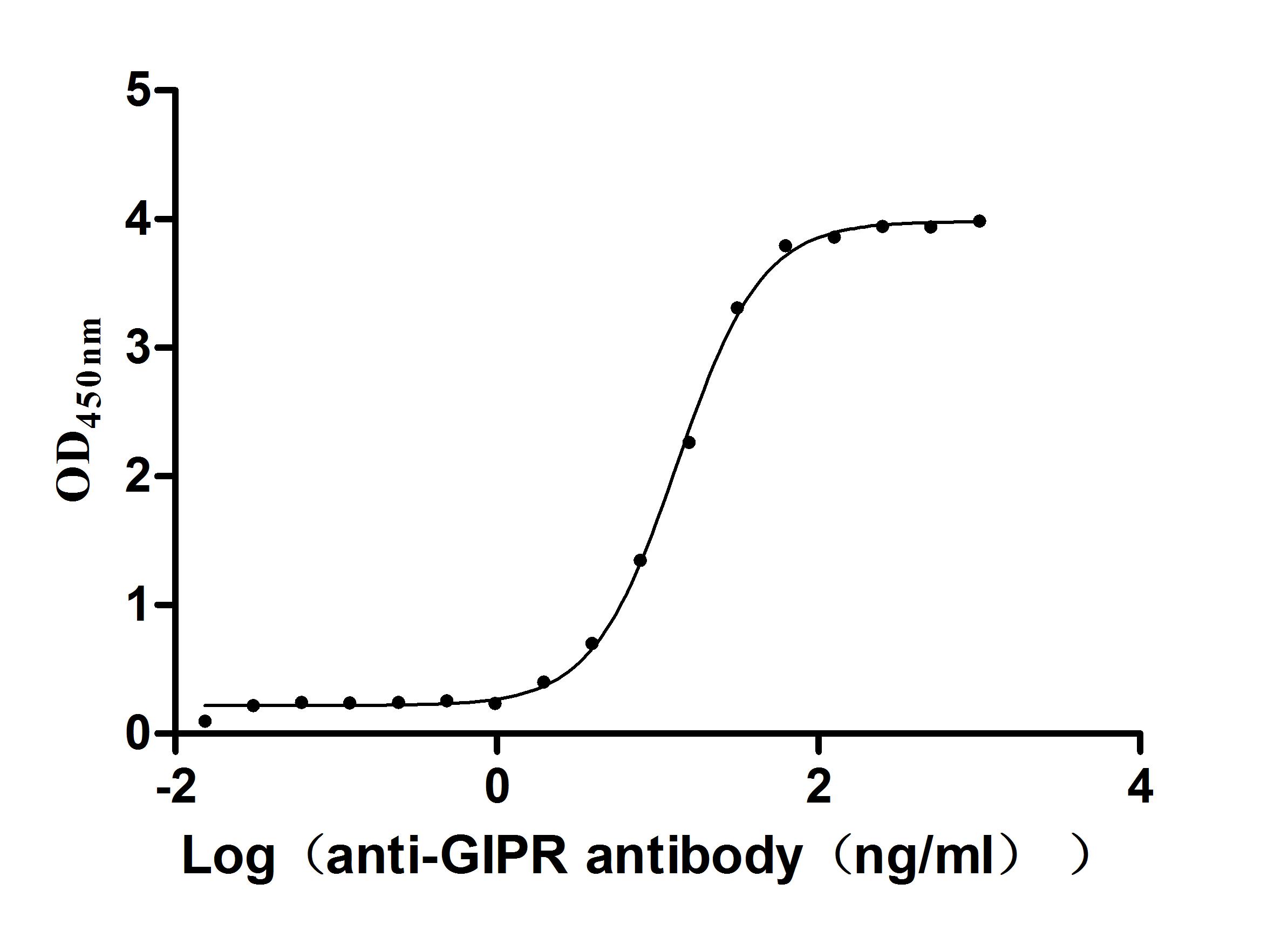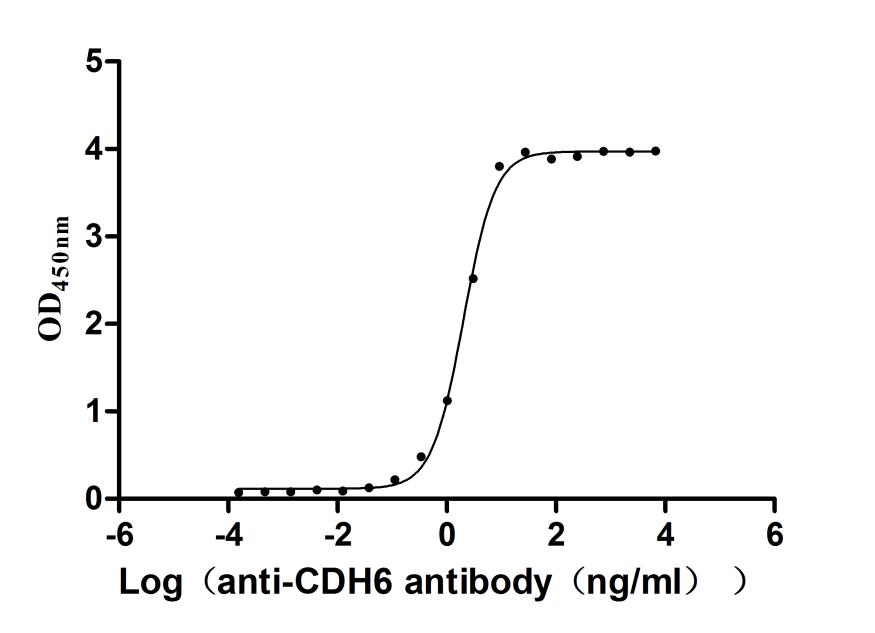Recombinant Human F-box/LRR-repeat protein 4 (FBXL4)
-
中文名称:人FBXL4重组蛋白
-
货号:CSB-YP891533HU
-
规格:
-
来源:Yeast
-
其他:
-
中文名称:人FBXL4重组蛋白
-
货号:CSB-EP891533HU
-
规格:
-
来源:E.coli
-
其他:
-
中文名称:人FBXL4重组蛋白
-
货号:CSB-EP891533HU-B
-
规格:
-
来源:E.coli
-
共轭:Avi-tag Biotinylated
E. coli biotin ligase (BirA) is highly specific in covalently attaching biotin to the 15 amino acid AviTag peptide. This recombinant protein was biotinylated in vivo by AviTag-BirA technology, which method is BriA catalyzes amide linkage between the biotin and the specific lysine of the AviTag.
-
其他:
-
中文名称:人FBXL4重组蛋白
-
货号:CSB-BP891533HU
-
规格:
-
来源:Baculovirus
-
其他:
-
中文名称:人FBXL4重组蛋白
-
货号:CSB-MP891533HU
-
规格:
-
来源:Mammalian cell
-
其他:
产品详情
-
纯度:>85% (SDS-PAGE)
-
基因名:FBXL4
-
Uniprot No.:
-
别名:FBXL4; FBL4; FBL5F-box/LRR-repeat protein 4; F-box and leucine-rich repeat protein 4; F-box protein FBL4/FBL5
-
种属:Homo sapiens (Human)
-
蛋白长度:full length protein
-
表达区域:1-621
-
氨基酸序列MSPVFPMLTV LTMFYYICLR RRARTATRGE MMNTHRAIES NSQTSPLNAE VVQYAKEVVD FSSHYGSENS MSYTMWNLAG VPNVFPSSGD FTQTAVFRTY GTWWDQCPSA SLPFKRTPPN FQSQDYVELT FEQQVYPTAV HVLETYHPGA VIRILACSAN PYSPNPPAEV RWEILWSERP TKVNASQARQ FKPCIKQINF PTNLIRLEVN SSLLEYYTEL DAVVLHGVKD KPVLSLKTSL IDMNDIEDDA YAEKDGCGMD SLNKKFSSAV LGEGPNNGYF DKLPYELIQL ILNHLTLPDL CRLAQTCKLL SQHCCDPLQY IHLNLQPYWA KLDDTSLEFL QSRCTLVQWL NLSWTGNRGF ISVAGFSRFL KVCGSELVRL ELSCSHFLNE TCLEVISEMC PNLQALNLSS CDKLPPQAFN HIAKLCSLKR LVLYRTKVEQ TALLSILNFC SELQHLSLGS CVMIEDYDVI ASMIGAKCKK LRTLDLWRCK NITENGIAEL ASGCPLLEEL DLGWCPTLQS STGCFTRLAH QLPNLQKLFL TANRSVCDTD IDELACNCTR LQQLDILGTR MVSPASLRKL LESCKDLSLL DVSFCSQIDN RAVLELNASF PKVFIKKSFT Q
-
蛋白标签:Tag type will be determined during the manufacturing process.
The tag type will be determined during production process. If you have specified tag type, please tell us and we will develop the specified tag preferentially. -
产品提供形式:Lyophilized powder
Note: We will preferentially ship the format that we have in stock, however, if you have any special requirement for the format, please remark your requirement when placing the order, we will prepare according to your demand. -
复溶:We recommend that this vial be briefly centrifuged prior to opening to bring the contents to the bottom. Please reconstitute protein in deionized sterile water to a concentration of 0.1-1.0 mg/mL.We recommend to add 5-50% of glycerol (final concentration) and aliquot for long-term storage at -20℃/-80℃. Our default final concentration of glycerol is 50%. Customers could use it as reference.
-
储存条件:Store at -20°C/-80°C upon receipt, aliquoting is necessary for mutiple use. Avoid repeated freeze-thaw cycles.
-
保质期:The shelf life is related to many factors, storage state, buffer ingredients, storage temperature and the stability of the protein itself.
Generally, the shelf life of liquid form is 6 months at -20°C/-80°C. The shelf life of lyophilized form is 12 months at -20°C/-80°C. -
货期:Delivery time may differ from different purchasing way or location, please kindly consult your local distributors for specific delivery time.Note: All of our proteins are default shipped with normal blue ice packs, if you request to ship with dry ice, please communicate with us in advance and extra fees will be charged.
-
注意事项:Repeated freezing and thawing is not recommended. Store working aliquots at 4°C for up to one week.
-
Datasheet :Please contact us to get it.
靶点详情
-
基因功能参考文献:
- Biallelic pathogenic variants in FBXL4 are associated with an encephalopathic mtDNA maintenance defect syndrome that is a multisystem disease. PMID: 28940506
- Overall, FBXL4 defects account for at least 0.7% (6 out of 808) of subjects suspected to have a mitochondrial disorder, and as high as 14.3% (4 out of 28) in young children with congenital lactic acidosis and clinical features of mitochondrial disease. Including FBLX4 in the mitochondrial diseases panel should be particularly important for patients with congenital lactic acidosis PMID: 27743463
- On clinical indication of mitochondrial encephalomyopathy, sequencing of FBXL4 should be performed, even when the activity levels of the MRC enzymes are normal PMID: 27182039
- A clinical pattern of early-onset encephalopathy, persistent lactic acidosis, profound muscular hypotonia and typical facial dysmorphism should prompt initiation of molecular genetic analysis of FBXL4. PMID: 25868664
- Mutations in FBXL4 are disease causing and establish FBXL4 as a mitochondrial protein with a possible role in maintaining mtDNA integrity and stability. PMID: 23993193
- These data strongly support a role for FBXL4 in controlling bioenergetic homeostasis and mtDNA maintenance. PMID: 23993194
- SKP1-Cul1-F-box and leucine-rich repeat protein 4 (SCF-FbxL4) ubiquitin ligase regulates lysine demethylase 4A (KDM4A)/Jumonji domain-containing 2A (JMJD2A) protein PMID: 21757720
显示更多
收起更多
-
相关疾病:Mitochondrial DNA depletion syndrome 13 (MTDPS13)
-
亚细胞定位:Cytoplasm. Nucleus. Mitochondrion.
-
组织特异性:Expressed in heart, kidney, liver, lung, pancreas, and placenta, but not in skeletal muscle.
-
数据库链接:
HGNC: 13601
OMIM: 605654
KEGG: hsa:26235
STRING: 9606.ENSP00000229971
UniGene: Hs.536850
Most popular with customers
-
Recombinant Human T-cell surface protein tactile (CD96), partial (Active)
Express system: Mammalian cell
Species: Homo sapiens (Human)
-
Recombinant Human Somatostatin receptor type 2 (SSTR2)-VLPs (Active)
Express system: Mammalian cell
Species: Homo sapiens (Human)
-
Recombinant Human Claudin-9 (CLDN9)-VLPs (Active)
Express system: Mammalian cell
Species: Homo sapiens (Human)
-
Recombinant Human Microtubule-associated protein tau (MAPT) (Active)
Express system: Mammalian cell
Species: Homo sapiens (Human)
-
Recombinant Human Glucagon-like peptide 1 receptor (GLP1R), partial (Active)
Express system: Mammalian cell
Species: Homo sapiens (Human)
-
Recombinant Macaca fascicularis Gastric inhibitory polypeptide receptor (GIPR), partial (Active)
Express system: yeast
Species: Macaca fascicularis (Crab-eating macaque) (Cynomolgus monkey)
-
Express system: Mammalian cell
Species: Homo sapiens (Human)
-
Recombinant Mouse Cadherin-6(Cdh6),partial (Active)
Express system: Mammalian cell
Species: Mus musculus (Mouse)


-AC1.jpg)


-AC1.jpg)














